MSc International Healthcare Leadership - Collective Leadership Report
VerifiedAdded on 2023/06/03
|8
|1221
|239
Report
AI Summary
This report examines the concept of collective leadership within the healthcare industry, using the ABS Health care center as a case study. It defines collective leadership as a social process focused on achieving shared goals through coordinated actions, highlighting the importance of communication, networking, and a patient-centered approach. The report explores the Collective Leadership Framework, emphasizing the individual, team, network, and organizational factors influencing leadership effectiveness. It discusses the purpose and aim of collective leadership, including the development of leadership skills, effective communication, and network building. The report also addresses patient-centered care, emphasizing the role of leadership in improving patient engagement and organizational structures. It concludes by summarizing the impact of collective leadership models on healthcare facilities, emphasizing the importance of values, intentions, and behaviors in uplifting organizational performance. The report references key literature on collective leadership, providing a comprehensive analysis of its application in the healthcare sector.

1
ASSIGNMENT 5 MODULE
1
UNDERSTANDING,
CREATING AND
DEMONSTRATING
COLLECTIVE
LEADERSHIP VALUES
ANONYMISED
PLEASE NOTE THAT THIS IS FOR GUIDANCE ONLY
ASSIGNMENT 5 MODULE
1
UNDERSTANDING,
CREATING AND
DEMONSTRATING
COLLECTIVE
LEADERSHIP VALUES
ANONYMISED
PLEASE NOTE THAT THIS IS FOR GUIDANCE ONLY
Paraphrase This Document
Need a fresh take? Get an instant paraphrase of this document with our AI Paraphraser
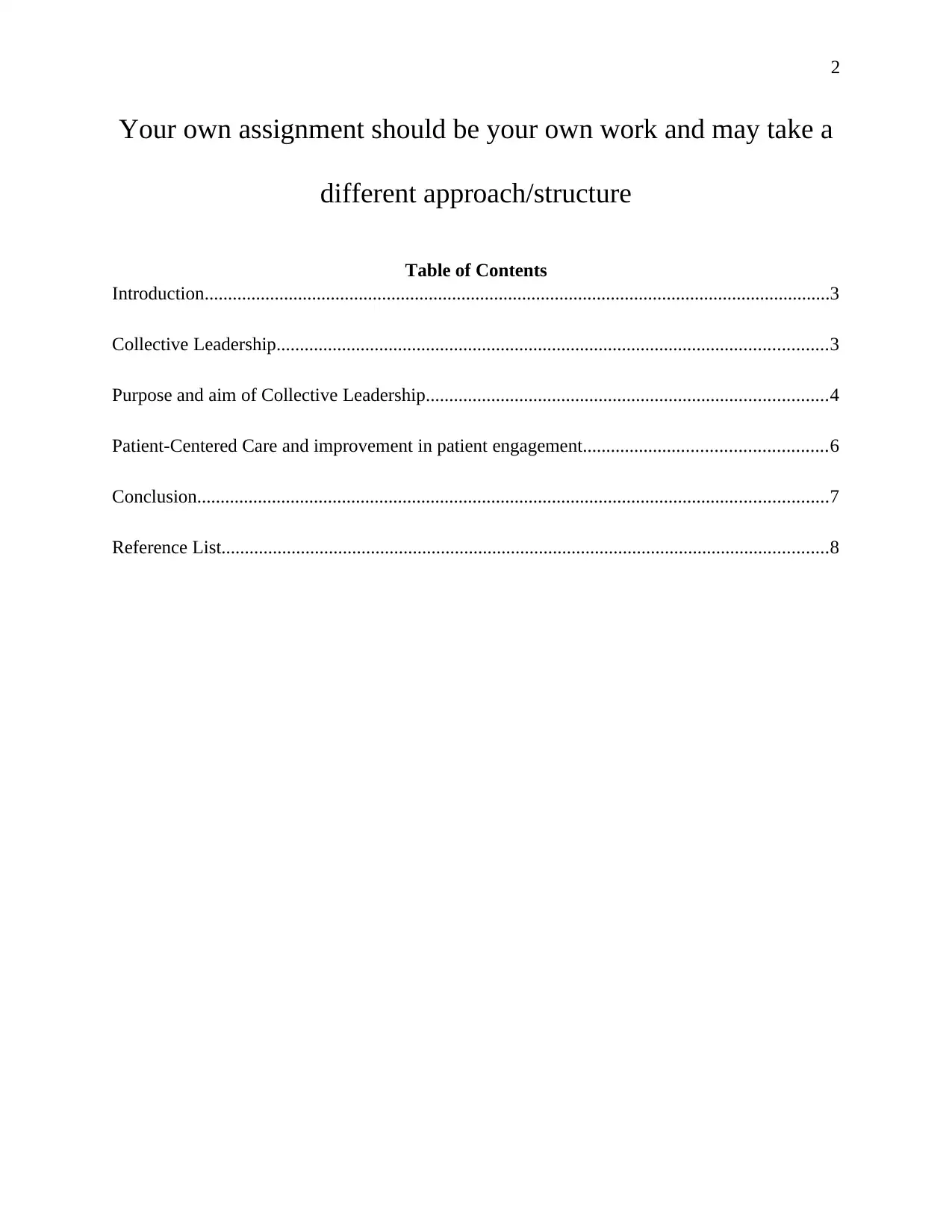
2
Your own assignment should be your own work and may take a
different approach/structure
Table of Contents
Introduction......................................................................................................................................3
Collective Leadership......................................................................................................................3
Purpose and aim of Collective Leadership......................................................................................4
Patient-Centered Care and improvement in patient engagement....................................................6
Conclusion.......................................................................................................................................7
Reference List..................................................................................................................................8
Your own assignment should be your own work and may take a
different approach/structure
Table of Contents
Introduction......................................................................................................................................3
Collective Leadership......................................................................................................................3
Purpose and aim of Collective Leadership......................................................................................4
Patient-Centered Care and improvement in patient engagement....................................................6
Conclusion.......................................................................................................................................7
Reference List..................................................................................................................................8
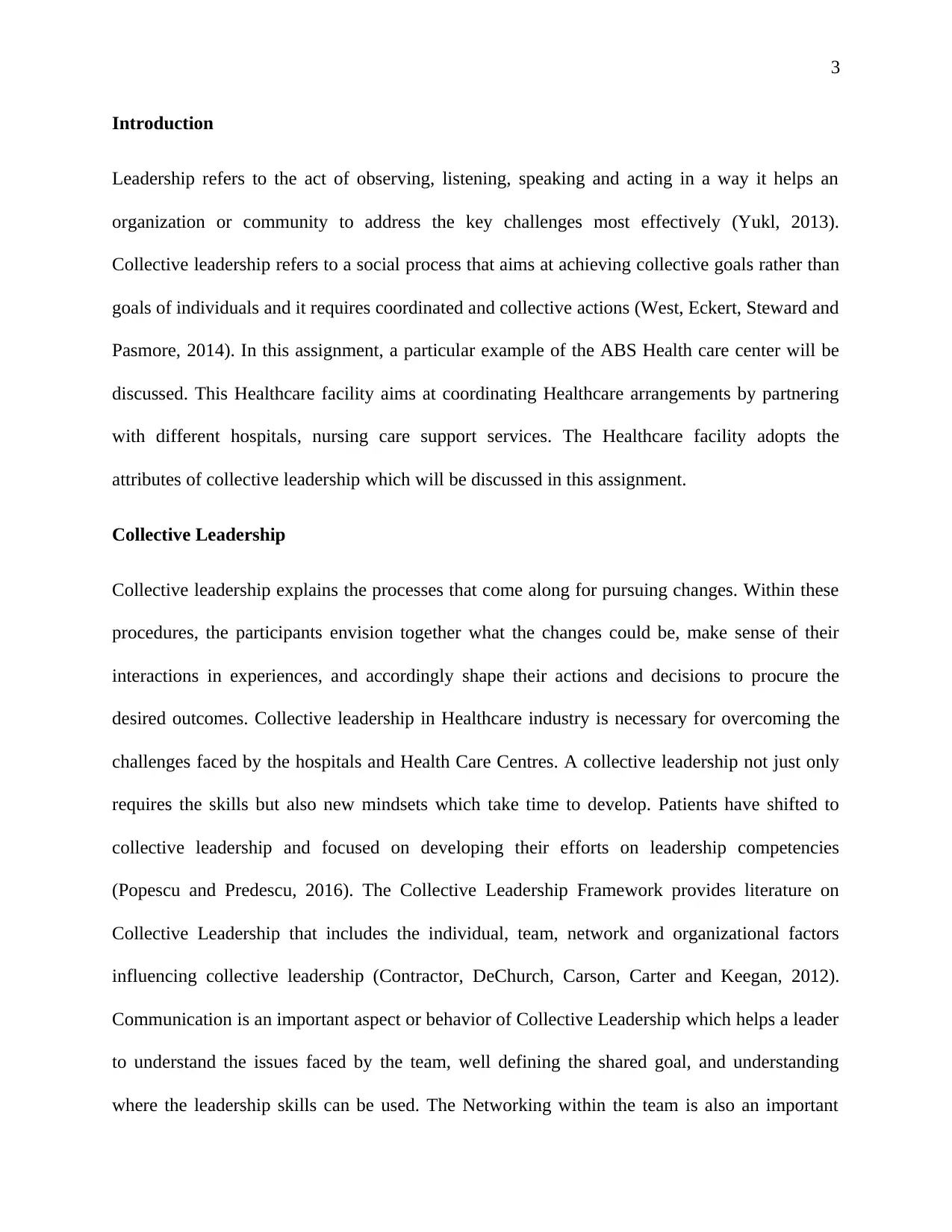
3
Introduction
Leadership refers to the act of observing, listening, speaking and acting in a way it helps an
organization or community to address the key challenges most effectively (Yukl, 2013).
Collective leadership refers to a social process that aims at achieving collective goals rather than
goals of individuals and it requires coordinated and collective actions (West, Eckert, Steward and
Pasmore, 2014). In this assignment, a particular example of the ABS Health care center will be
discussed. This Healthcare facility aims at coordinating Healthcare arrangements by partnering
with different hospitals, nursing care support services. The Healthcare facility adopts the
attributes of collective leadership which will be discussed in this assignment.
Collective Leadership
Collective leadership explains the processes that come along for pursuing changes. Within these
procedures, the participants envision together what the changes could be, make sense of their
interactions in experiences, and accordingly shape their actions and decisions to procure the
desired outcomes. Collective leadership in Healthcare industry is necessary for overcoming the
challenges faced by the hospitals and Health Care Centres. A collective leadership not just only
requires the skills but also new mindsets which take time to develop. Patients have shifted to
collective leadership and focused on developing their efforts on leadership competencies
(Popescu and Predescu, 2016). The Collective Leadership Framework provides literature on
Collective Leadership that includes the individual, team, network and organizational factors
influencing collective leadership (Contractor, DeChurch, Carson, Carter and Keegan, 2012).
Communication is an important aspect or behavior of Collective Leadership which helps a leader
to understand the issues faced by the team, well defining the shared goal, and understanding
where the leadership skills can be used. The Networking within the team is also an important
Introduction
Leadership refers to the act of observing, listening, speaking and acting in a way it helps an
organization or community to address the key challenges most effectively (Yukl, 2013).
Collective leadership refers to a social process that aims at achieving collective goals rather than
goals of individuals and it requires coordinated and collective actions (West, Eckert, Steward and
Pasmore, 2014). In this assignment, a particular example of the ABS Health care center will be
discussed. This Healthcare facility aims at coordinating Healthcare arrangements by partnering
with different hospitals, nursing care support services. The Healthcare facility adopts the
attributes of collective leadership which will be discussed in this assignment.
Collective Leadership
Collective leadership explains the processes that come along for pursuing changes. Within these
procedures, the participants envision together what the changes could be, make sense of their
interactions in experiences, and accordingly shape their actions and decisions to procure the
desired outcomes. Collective leadership in Healthcare industry is necessary for overcoming the
challenges faced by the hospitals and Health Care Centres. A collective leadership not just only
requires the skills but also new mindsets which take time to develop. Patients have shifted to
collective leadership and focused on developing their efforts on leadership competencies
(Popescu and Predescu, 2016). The Collective Leadership Framework provides literature on
Collective Leadership that includes the individual, team, network and organizational factors
influencing collective leadership (Contractor, DeChurch, Carson, Carter and Keegan, 2012).
Communication is an important aspect or behavior of Collective Leadership which helps a leader
to understand the issues faced by the team, well defining the shared goal, and understanding
where the leadership skills can be used. The Networking within the team is also an important
⊘ This is a preview!⊘
Do you want full access?
Subscribe today to unlock all pages.

Trusted by 1+ million students worldwide
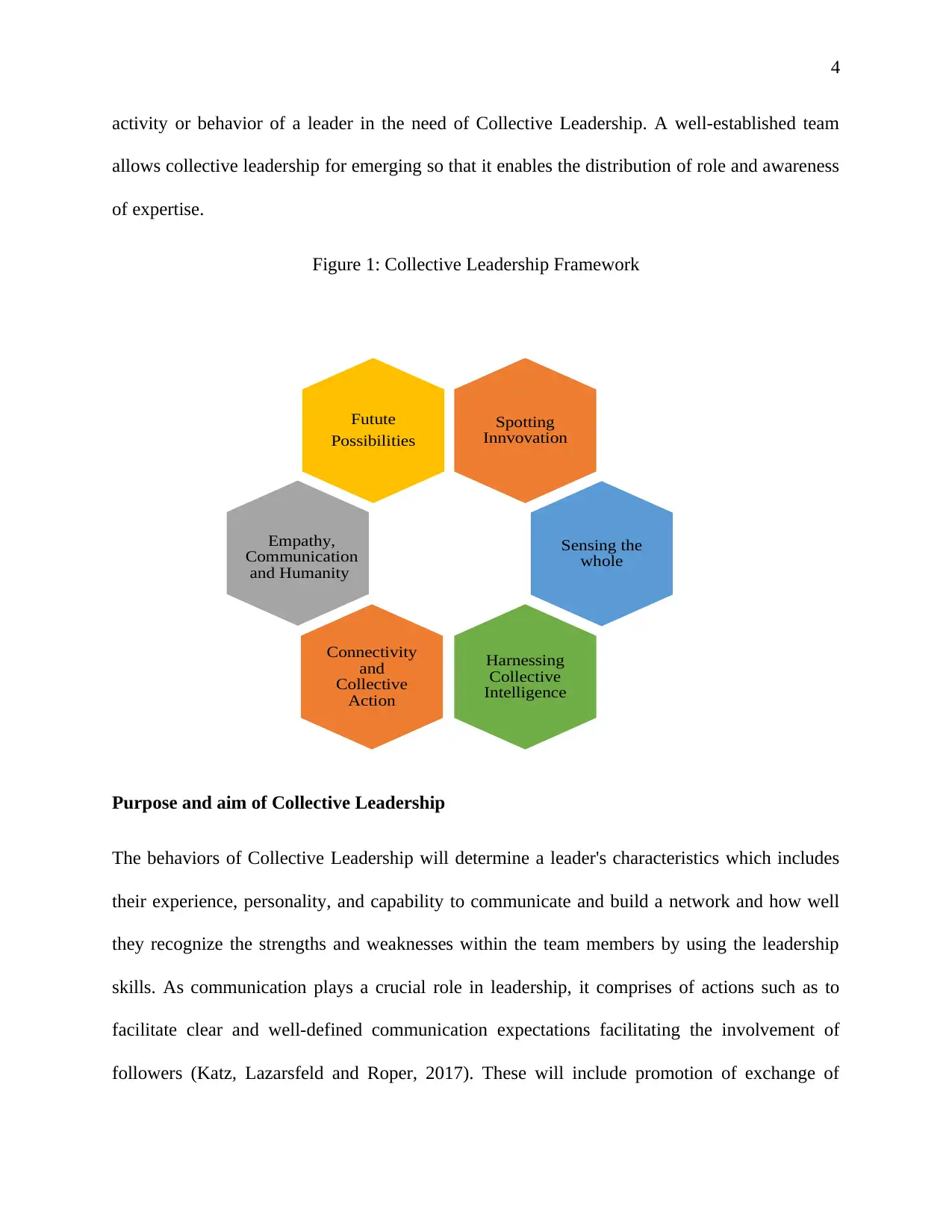
4
activity or behavior of a leader in the need of Collective Leadership. A well-established team
allows collective leadership for emerging so that it enables the distribution of role and awareness
of expertise.
Figure 1: Collective Leadership Framework
Purpose and aim of Collective Leadership
The behaviors of Collective Leadership will determine a leader's characteristics which includes
their experience, personality, and capability to communicate and build a network and how well
they recognize the strengths and weaknesses within the team members by using the leadership
skills. As communication plays a crucial role in leadership, it comprises of actions such as to
facilitate clear and well-defined communication expectations facilitating the involvement of
followers (Katz, Lazarsfeld and Roper, 2017). These will include promotion of exchange of
Spotting
Innvovation
Futute
Possibilities
Empathy,
Communication
and Humanity
Sensing the
whole
Harnessing
Collective
Intelligence
Connectivity
and
Collective
Action
activity or behavior of a leader in the need of Collective Leadership. A well-established team
allows collective leadership for emerging so that it enables the distribution of role and awareness
of expertise.
Figure 1: Collective Leadership Framework
Purpose and aim of Collective Leadership
The behaviors of Collective Leadership will determine a leader's characteristics which includes
their experience, personality, and capability to communicate and build a network and how well
they recognize the strengths and weaknesses within the team members by using the leadership
skills. As communication plays a crucial role in leadership, it comprises of actions such as to
facilitate clear and well-defined communication expectations facilitating the involvement of
followers (Katz, Lazarsfeld and Roper, 2017). These will include promotion of exchange of
Spotting
Innvovation
Futute
Possibilities
Empathy,
Communication
and Humanity
Sensing the
whole
Harnessing
Collective
Intelligence
Connectivity
and
Collective
Action
Paraphrase This Document
Need a fresh take? Get an instant paraphrase of this document with our AI Paraphraser
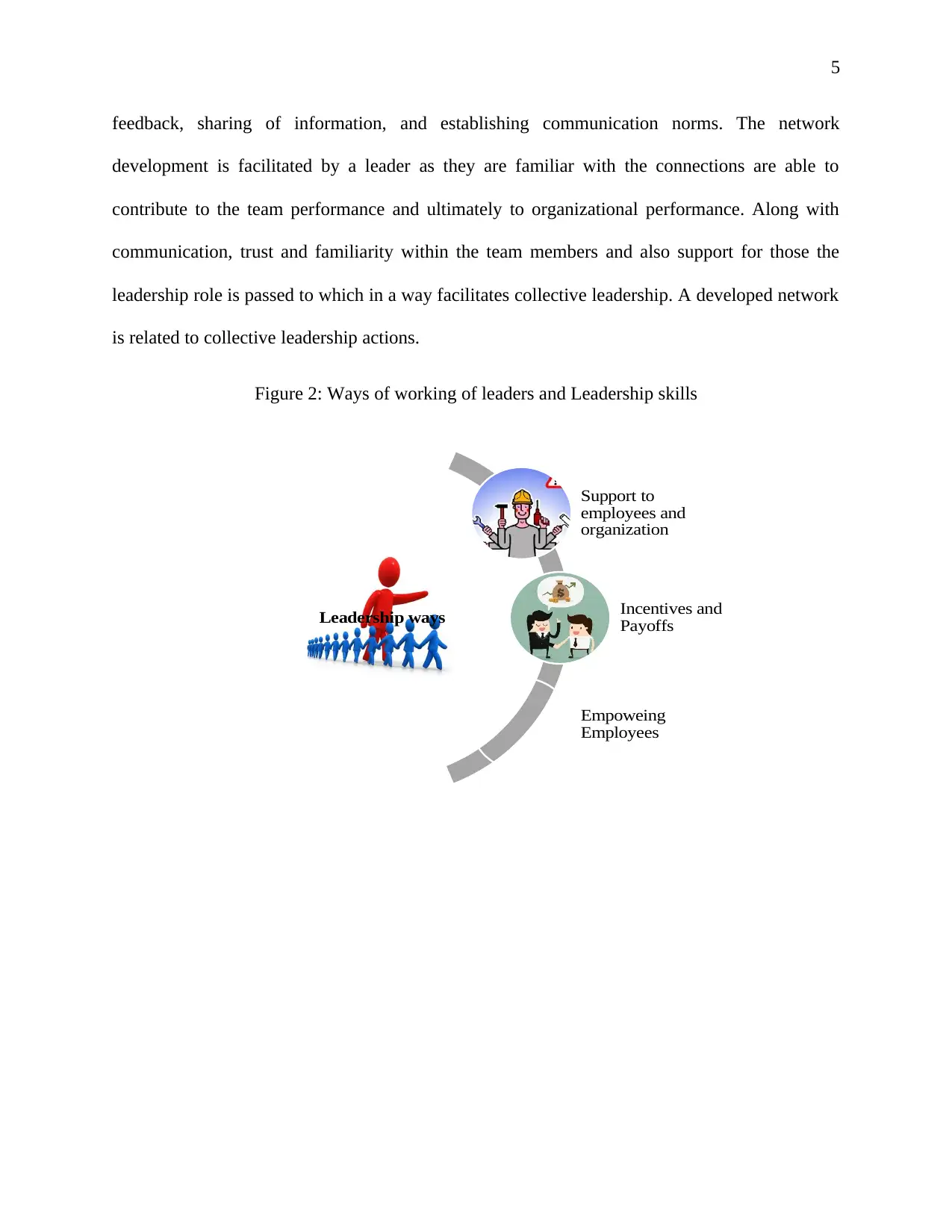
5
feedback, sharing of information, and establishing communication norms. The network
development is facilitated by a leader as they are familiar with the connections are able to
contribute to the team performance and ultimately to organizational performance. Along with
communication, trust and familiarity within the team members and also support for those the
leadership role is passed to which in a way facilitates collective leadership. A developed network
is related to collective leadership actions.
Figure 2: Ways of working of leaders and Leadership skills
Leadership ways
Support to
employees and
organization
Incentives and
Payoffs
Empoweing
Employees
feedback, sharing of information, and establishing communication norms. The network
development is facilitated by a leader as they are familiar with the connections are able to
contribute to the team performance and ultimately to organizational performance. Along with
communication, trust and familiarity within the team members and also support for those the
leadership role is passed to which in a way facilitates collective leadership. A developed network
is related to collective leadership actions.
Figure 2: Ways of working of leaders and Leadership skills
Leadership ways
Support to
employees and
organization
Incentives and
Payoffs
Empoweing
Employees
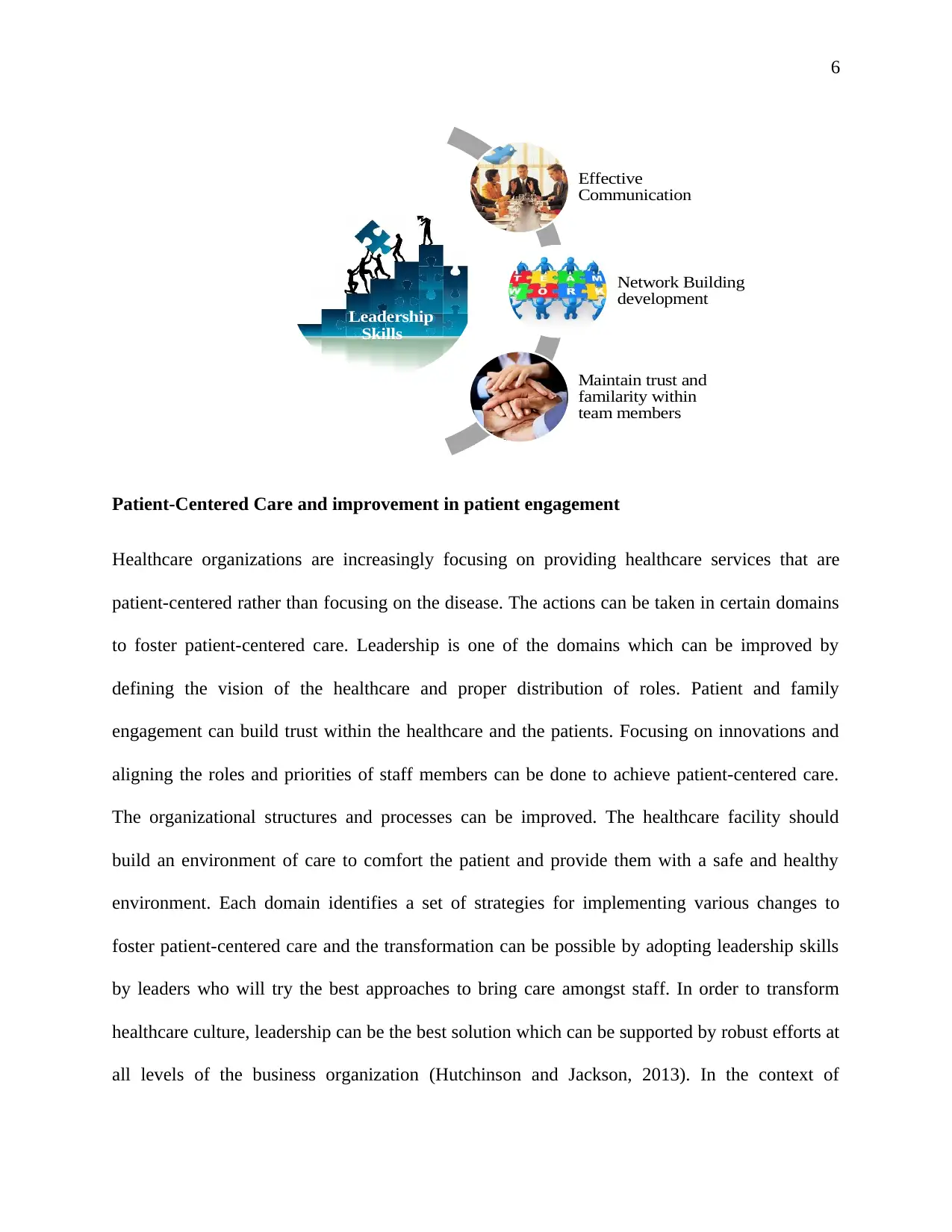
6
Patient-Centered Care and improvement in patient engagement
Healthcare organizations are increasingly focusing on providing healthcare services that are
patient-centered rather than focusing on the disease. The actions can be taken in certain domains
to foster patient-centered care. Leadership is one of the domains which can be improved by
defining the vision of the healthcare and proper distribution of roles. Patient and family
engagement can build trust within the healthcare and the patients. Focusing on innovations and
aligning the roles and priorities of staff members can be done to achieve patient-centered care.
The organizational structures and processes can be improved. The healthcare facility should
build an environment of care to comfort the patient and provide them with a safe and healthy
environment. Each domain identifies a set of strategies for implementing various changes to
foster patient-centered care and the transformation can be possible by adopting leadership skills
by leaders who will try the best approaches to bring care amongst staff. In order to transform
healthcare culture, leadership can be the best solution which can be supported by robust efforts at
all levels of the business organization (Hutchinson and Jackson, 2013). In the context of
Leadership
Skills
Effective
Communication
Network Building
development
Maintain trust and
familarity within
team members
Patient-Centered Care and improvement in patient engagement
Healthcare organizations are increasingly focusing on providing healthcare services that are
patient-centered rather than focusing on the disease. The actions can be taken in certain domains
to foster patient-centered care. Leadership is one of the domains which can be improved by
defining the vision of the healthcare and proper distribution of roles. Patient and family
engagement can build trust within the healthcare and the patients. Focusing on innovations and
aligning the roles and priorities of staff members can be done to achieve patient-centered care.
The organizational structures and processes can be improved. The healthcare facility should
build an environment of care to comfort the patient and provide them with a safe and healthy
environment. Each domain identifies a set of strategies for implementing various changes to
foster patient-centered care and the transformation can be possible by adopting leadership skills
by leaders who will try the best approaches to bring care amongst staff. In order to transform
healthcare culture, leadership can be the best solution which can be supported by robust efforts at
all levels of the business organization (Hutchinson and Jackson, 2013). In the context of
Leadership
Skills
Effective
Communication
Network Building
development
Maintain trust and
familarity within
team members
⊘ This is a preview!⊘
Do you want full access?
Subscribe today to unlock all pages.

Trusted by 1+ million students worldwide
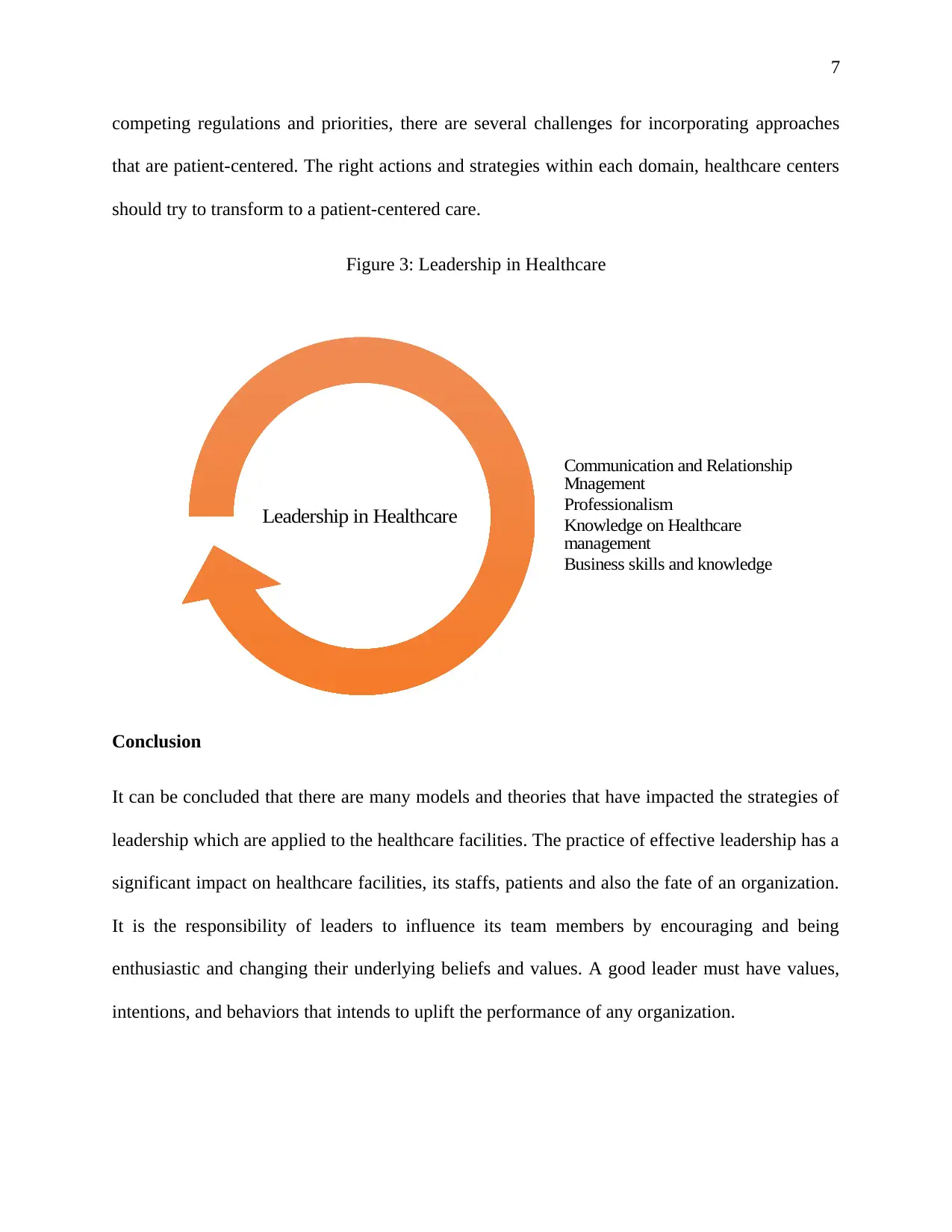
7
competing regulations and priorities, there are several challenges for incorporating approaches
that are patient-centered. The right actions and strategies within each domain, healthcare centers
should try to transform to a patient-centered care.
Figure 3: Leadership in Healthcare
Conclusion
It can be concluded that there are many models and theories that have impacted the strategies of
leadership which are applied to the healthcare facilities. The practice of effective leadership has a
significant impact on healthcare facilities, its staffs, patients and also the fate of an organization.
It is the responsibility of leaders to influence its team members by encouraging and being
enthusiastic and changing their underlying beliefs and values. A good leader must have values,
intentions, and behaviors that intends to uplift the performance of any organization.
Communication and Relationship
Mnagement
Professionalism
Knowledge on Healthcare
management
Business skills and knowledge
Leadership in Healthcare
competing regulations and priorities, there are several challenges for incorporating approaches
that are patient-centered. The right actions and strategies within each domain, healthcare centers
should try to transform to a patient-centered care.
Figure 3: Leadership in Healthcare
Conclusion
It can be concluded that there are many models and theories that have impacted the strategies of
leadership which are applied to the healthcare facilities. The practice of effective leadership has a
significant impact on healthcare facilities, its staffs, patients and also the fate of an organization.
It is the responsibility of leaders to influence its team members by encouraging and being
enthusiastic and changing their underlying beliefs and values. A good leader must have values,
intentions, and behaviors that intends to uplift the performance of any organization.
Communication and Relationship
Mnagement
Professionalism
Knowledge on Healthcare
management
Business skills and knowledge
Leadership in Healthcare
Paraphrase This Document
Need a fresh take? Get an instant paraphrase of this document with our AI Paraphraser
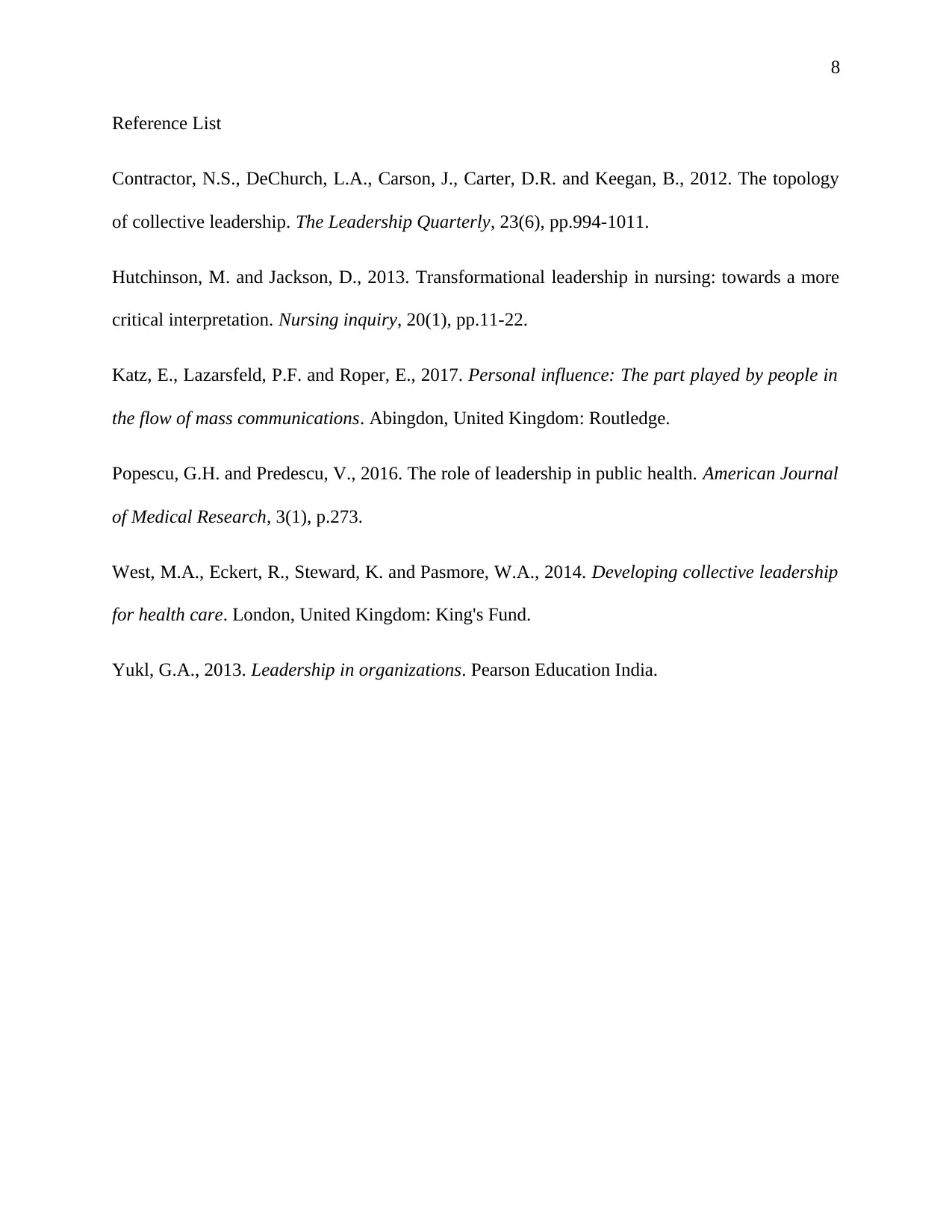
8
Reference List
Contractor, N.S., DeChurch, L.A., Carson, J., Carter, D.R. and Keegan, B., 2012. The topology
of collective leadership. The Leadership Quarterly, 23(6), pp.994-1011.
Hutchinson, M. and Jackson, D., 2013. Transformational leadership in nursing: towards a more
critical interpretation. Nursing inquiry, 20(1), pp.11-22.
Katz, E., Lazarsfeld, P.F. and Roper, E., 2017. Personal influence: The part played by people in
the flow of mass communications. Abingdon, United Kingdom: Routledge.
Popescu, G.H. and Predescu, V., 2016. The role of leadership in public health. American Journal
of Medical Research, 3(1), p.273.
West, M.A., Eckert, R., Steward, K. and Pasmore, W.A., 2014. Developing collective leadership
for health care. London, United Kingdom: King's Fund.
Yukl, G.A., 2013. Leadership in organizations. Pearson Education India.
Reference List
Contractor, N.S., DeChurch, L.A., Carson, J., Carter, D.R. and Keegan, B., 2012. The topology
of collective leadership. The Leadership Quarterly, 23(6), pp.994-1011.
Hutchinson, M. and Jackson, D., 2013. Transformational leadership in nursing: towards a more
critical interpretation. Nursing inquiry, 20(1), pp.11-22.
Katz, E., Lazarsfeld, P.F. and Roper, E., 2017. Personal influence: The part played by people in
the flow of mass communications. Abingdon, United Kingdom: Routledge.
Popescu, G.H. and Predescu, V., 2016. The role of leadership in public health. American Journal
of Medical Research, 3(1), p.273.
West, M.A., Eckert, R., Steward, K. and Pasmore, W.A., 2014. Developing collective leadership
for health care. London, United Kingdom: King's Fund.
Yukl, G.A., 2013. Leadership in organizations. Pearson Education India.
1 out of 8
Related Documents
Your All-in-One AI-Powered Toolkit for Academic Success.
+13062052269
info@desklib.com
Available 24*7 on WhatsApp / Email
![[object Object]](/_next/static/media/star-bottom.7253800d.svg)
Unlock your academic potential
Copyright © 2020–2025 A2Z Services. All Rights Reserved. Developed and managed by ZUCOL.





